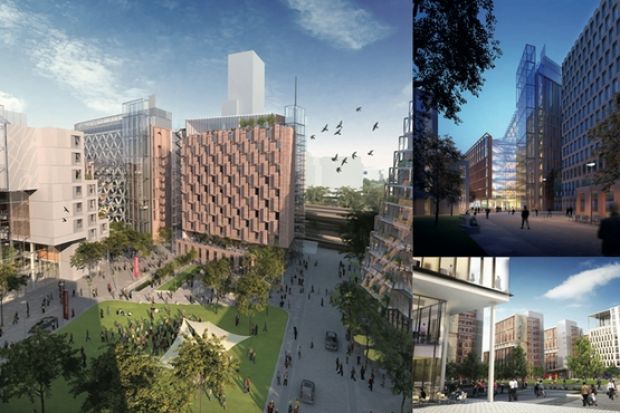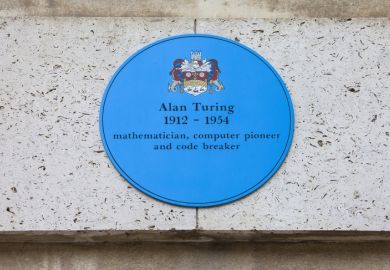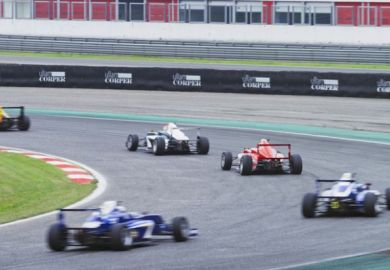Crosstown traffic: rector Sir Keith O’Nions said staff initially reluctant to consider leaving South Kensington are now keen on transfers to the ‘ecosystem’ in White City
People living and working near the BBC’s former Woodlands site in West London may notice a distinct change in the feel of the area from 2015.
By then the low, brown BBC Worldwide building and its journalist occupants will have been long since replaced by shiny new facilities at the heart of a major new development for Imperial College London.
The £1 billion Imperial West campus, north of White City and alongside the famous Westway, will be a first for the capital, said Imperial’s rector and president, Sir Keith O’Nions.
“It’s not a campus that’s basically a replacement of activity or a simple expansion of activity here in South Kensington [at Imperial’s main campus],” he told Times Higher Education.
Instead it will be an “ecosystem” of interdisciplinary research, postgraduate activities and, crucially, translation and commercialisation, including space to “co-locate” spin-off companies and businesses, he said.
Translation is a “real imperative” of the UK government and a practice that Imperial, like other Russell Group universities, is increasingly adopting, said Sir Keith.
The campus will be unique in the UK, more akin to the set-up at the Massachusetts Institute of Technology - which hosts university spin-offs and multinational companies on site - than to the existing clusters and science parks in this country, he added.
“Given the huge density of research activity in London, [space for spin-off companies] is one of the things that is very obviously absent from our academic activity. So when we spin companies out, they often spin a hell of a long way out,” Sir Keith said.
At the heart of the Imperial West development is a £150 million research and innovation hub, for which the college was awarded £35 million from the government’s UK Research Partnership Investment Fund (RPIF) last year. The building will house around 1,000 researchers, working broadly in “next generation materials” in fields such as biomedicine and plastic electronics, as well as “incubator” space for 50 spin-off companies.
The government scheme requires that public investment is matched at least two to one by a private investor. Imperial’s partner, real estate funder Voreda Capital, will put £90 million into the hub.
Preparedness (and a shovel) pays
According to Sir Keith, part of the reason the project was awarded a sizeable chunk of the £300 million government scheme - which has so far given money to 14 projects, 10 of them at Russell Group universities - was because the plans were “shovel ready”.
Unless universities had “a fairly good idea of how they were going to do it…and a few numbers lined up, it wouldn’t have been possible”, he acknowledged.
Private investment will also help to build a 35-storey tower block of homes for key workers, Imperial staff and private residents on the site, while further private money will be sought for a “joint venture” for an on-site hotel and conference centre.
Imperial West’s funding model, in which a private partner makes a capital investment that it later recovers through rent over 25-30 years, is one that Sir Keith expects to be replicated across UK higher education in the future.
Government capital is scarce, he said, with Imperial’s funding outside the UK RPIF scheme dropping in recent years from about £50 million to just £12 million a year. Meanwhile, global financial uncertainties mean that well- established universities are safe, long-term partners for private investors, he added.
“If we thought the government would be giving us £100 million in capital every year…we probably wouldn’t go down this route. But we don’t think that’s a realistic possibility and we’ve persuaded ourselves that we need to find more innovative ways to capitalise these developments,” he said.
Imperial West will also comprise Wood Lane Studios (an already finished complex with accommodation for more than 600 postgraduate students and early career researchers), two further research buildings, leisure and retail facilities, a medical clinic, a crèche and a publicly accessible square.
Making the campus culturally attractive and complementary to the South Kensington campus, rather than secondary to it, is imperative, said Sir Keith.
“This is only going to work if…it’s got the ability to become a community and have the opportunities for the people working here that are comparable to elsewhere,” he said.
Many academics will make the move from South Kensington to Imperial West, but no one will be obliged to. Sir Keith said that although the initial reaction among staff was “it’s a great place for people to go, but don’t ask me to”, now that plans are taking shape, there is a groundswell of enthusiasm from far more Imperial researchers than can be accommodated there.
Go west: it’s near and less dear
But why expand into West London at all? South Kensington is both expensive and full, Sir Keith noted, with land costing more than 10 times more than it does around White City, where it can still reach an eye-watering £10 million an acre.
The site is relatively near Imperial’s main campus, and crucially just 500m from the £66 million Imperial Centre for Translational and Experimental Medicine, opened last year, and Hammersmith Hospital, a major research and teaching hospital for the college. There is also some potential for further expansion, said Sir Keith.
At a launch event on 6 March, the president and rector - who retires at the end of 2013 - was due to say that he planned to call on other universities and businesses to get involved with the campus, which had planning permission granted in July last year.
The mayor of London, Boris Johnson, and Nick Botterill, leader of Hammersmith and Fulham Council, both support the development, which Mr Botterill called “an exciting venture” that would bring an estimated 3,000 jobs to the borough.
But not all local residents are thrilled, especially those across a railway line from the site in the borough of Kensington and Chelsea.
Members of the St Helen’s Residents Association said that although they do not oppose the range of academic and medical uses proposed for the site, they take issue with its private funders and commercial uses, in particular a tower that will “destroy the western skyline” and open up the area for more such development.
Sir Keith said it was important that their voices were heard, but added that such concerns were understandable in “any change in any urban area of any sort”.
Ultimately, local residents would benefit from investment in a part of Hammersmith and Fulham that was “something of a deprived area”, he said. “Clearly our mission is academic, but [regeneration] is a very positive addition to it,” he added.
The research and innovation hub will be open by early 2015, with the two further academic buildings completed soon after.
However, the complexity of the financial arrangements being used for the campus as a whole means that Imperial West in all its glory is not likely to be finished before 2020, said Sir Keith - that is unless, of course, anyone has a spare £500 million.
Register to continue
Why register?
- Registration is free and only takes a moment
- Once registered, you can read 3 articles a month
- Sign up for our newsletter
Subscribe
Or subscribe for unlimited access to:
- Unlimited access to news, views, insights & reviews
- Digital editions
- Digital access to THE’s university and college rankings analysis
Already registered or a current subscriber? Login




